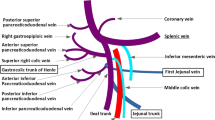Summary
The effects of portacaval shunt with and without arterialization of the hepatic portal vein were studied in dogs. An end-to-side portacaval shunt was performed in all animals, and in one group this was followed by the interposition of an external jugular vein graft between the hepatic stump of the portal vein and the abdominal aorta. The dogs were observed over a period of 10 weeks.
Portocaval shunt alone caused a decrease in liver blood flow from 38.5 ± 13.3 to 10.5 ± 1.7 ml/kg/min (P < 0.001), hepatic atrophy, impaired indocyanin green clearance from 101 ± 022 to 053 ± 014 (P < 0.001) and increased concentrations of ammonia from 48 ± 13 to 155 ± 36 (P < 0.001) and bile acids from 3 ± 2 to 239 ± 93 (P < 0.001) in the peripheral blood.
These effects were prevented by arterilization of the liver. Thrombosis of the arterial graft and increase in intrahepatic blood pressure were the two major complications of arterialization which were observed.
These findings indicate that depriving the liver of portal blood causes pathophysiological changes which may be responsible for the well known complications of liver failure and encephalopathy observed following portocaval anastomosis in cirrhotic patients. The fact that arterialization of the portal vein minimizes these changes encourages the application of this procedure in the treatment of portal hypertension in man.
Zusammenfassung
Die pathophysiologischen Veränderungen des portocavalen Shunt und der Einfluß der Arterialisation der Leber auf diese Mechanismen wurden an Hunden untersucht. Ein portocavaler End-zu-Seit-Shunt wurde bei allen Tieren durchgeführt. In einer Gruppe wurde durch Interposition der V. jugularis externa zwischen dem Stumpf der Pfortader und der Aorta abdominalis eine druck- und durchflußkontrollierte Arterialisation der Leber angeschlossen. Die Tiere wurden 10 Wochen beobachtet.
Der portocavale Shunt führte zu einer Reduktion des Leberblutflusses von 38,5 ± 13,3 auf 10,5 ± 1,7 ml/kg/min (P < 0,001) zur Atrophie der Leber, zur Einschränkung der Indocyaningrün-Clearance von 101 ± 022 auf 053 ± 014 (P < 0,001) und zum Anstieg der Konzentration von Ammoniak von 48 ± 13 auf 155 +- 36 (P < 0,001) und Gallensäuren von 3 ± 2 auf 239 ± 93 (P < 0,001) im peripheren Blut. Durch Arterialisation konnten diese pathologischen Veränderungen weitgehend vermieden werden.
Die beiden wichtigsten Komplikationen der Arterialisation waren Thrombose des Interponates und Anstieg des intrahepatalen Druckes.
Diese Ergebnisse zeigen, daß durch den portocavalen Shunt pathophysiologische Veränderungen entstehen, welche die bekannten Komplikationen Leberinsuffizienz und Encephalopathie beim Cirrhosepatienten verursachen können. Der günstige Effekt der Arterialisation auf diese Veränderungen stimuliert die Anwendung dieser Methode zur Behandlung der portalen Hypertension von Patienten mit Lebercirrhose.
Similar content being viewed by others
Literatur
Cohn, R., Herrod, C.: Some effects upon the liver of complete arterilization of its blood supply. Surgery32, 214–218 (1952)
Fisher, B., Fisher, E. R., Lee, S.: Experimental evaluation of liver atrophy and portacaval shunt. Surg. Gynec. Obstet.125, 1253–1258 (1967)
Fisher, B., Russ, C., Fedor, E., Wilde, R., Engstrom, P., Fisher, E. R.: Further experimental observations on animals with arterialized livers. Surgery38, 181–193 (1955)
Hutchinson, J. H., Labby, D. H.: New method for microdetermination of blood ammonia by use of cation exchange resin. J. Lab. clin. Med.60, 170–178 (1962)
Mallet-Guy, P., Kayabali, I., Feroldi, J., Mallet-Guy, Y.: Arterialisation experimentale de la veine porte. Données histologiques et ultrastructurales. Presse méd.76, 1221–1225 (1968)
Mayer, D., Haindl, H., Koss, F. W., Lamprecht, W.: Enzymatische Bestimmung von Gallensäuren in Körperflüssigkeiten und Geweben. Z. anal. Chem.243, 242–248 (1968)
Murphy, G. M., Billing, B. H., Baron, D. N.: A fluorimetric and enzymatic method for the estimation of serum total bile acids. J. clin. Path.23, 594–598 (1970)
Paumgartner, G., Probst, P., Kraines, R., Leevy, C. M.: Kinetics of indocyanine green removal from the blood. Ann. N. Y. Acad. Sci.170, 134–147 (1970)
Reichle, F. A., Siplet, H., Tomasello, P. A., Alfonso, A., Reichle, R. M., Noorjehan, E., Rosemond, G. P.: Effect of end-to-side and side-to-side portacaval shunt on liver function. Amer. J. Gastroent.60, 114–121 (1973)
Restrepo, J. E., Warren, W. D.: Total liver blood flow after portacaval shunts, hepatic artery ligation and 70 per cent hepatectomy. Ann. Surg.156, 719–726 (1962)
Rubin, E., Gevirtz, N. R., Cohan, P., Tomita, F., Jacobson II, J. H.: Liver cell damage produced by portocaval shunts. Proc. Soc. exp. Biol. (N. Y.)118, 235–237 (1965)
Schwartz, S. I., Morton, J. H., McGovern, G. R.: Experimental arterialization of the liver. Surgery49, 611–617 (1961)
Tutassaura, H., Baird, R. J.: Hemodynamic observations following arterialization of the portal vein. Arch. Surg.104, 696–701 (1972)
Author information
Authors and Affiliations
Rights and permissions
About this article
Cite this article
Funovics, J., Gangl, A., Horak, W. et al. Die kontrollierte arterialisation der leber. Langenbecks Arch Chiv 335, 339–349 (1974). https://doi.org/10.1007/BF01261010
Received:
Issue Date:
DOI: https://doi.org/10.1007/BF01261010




